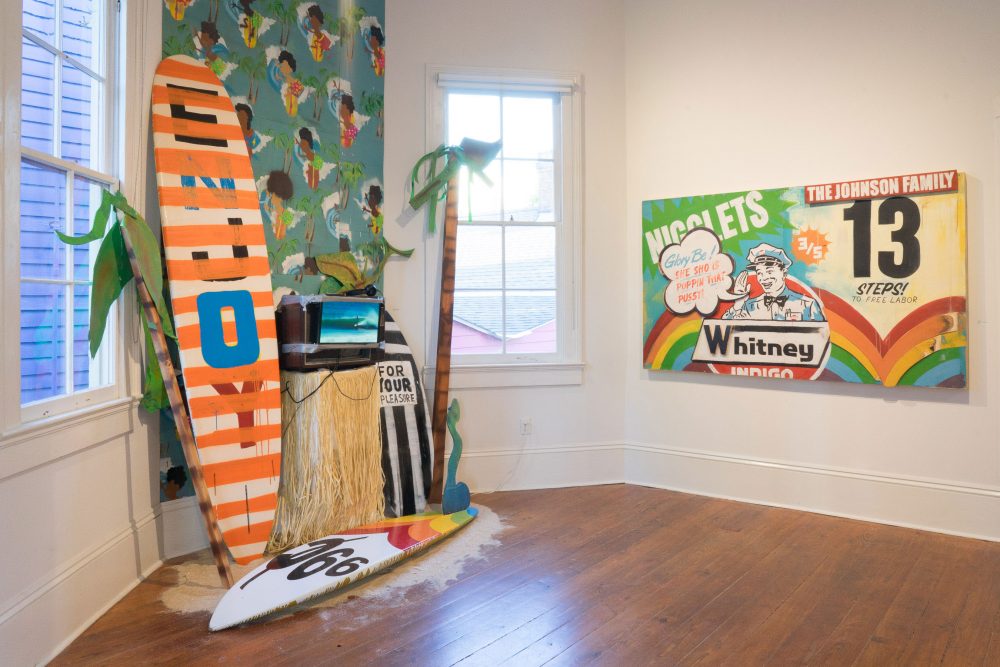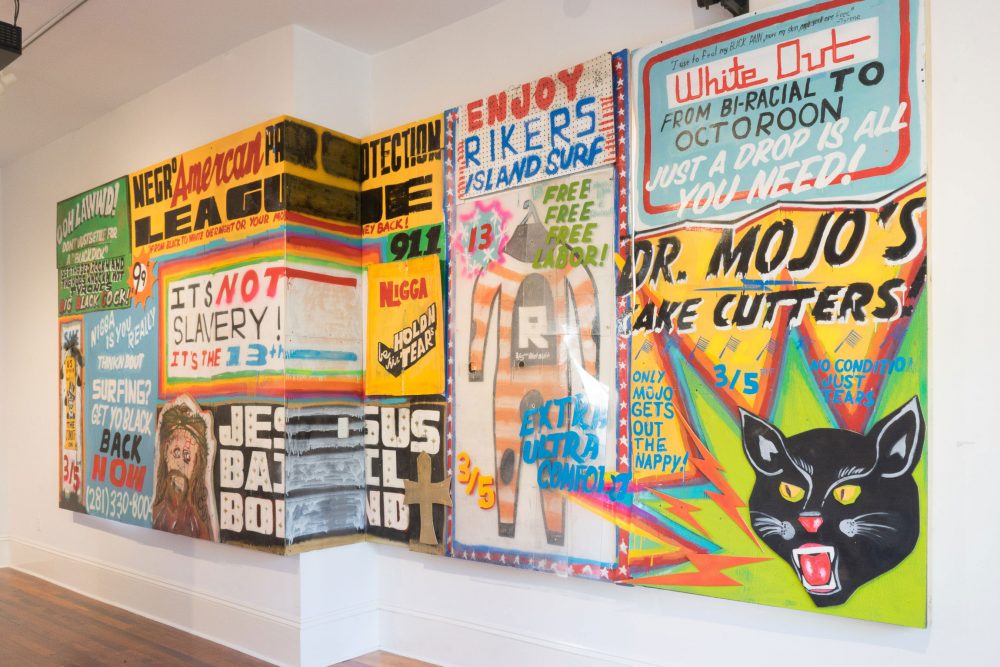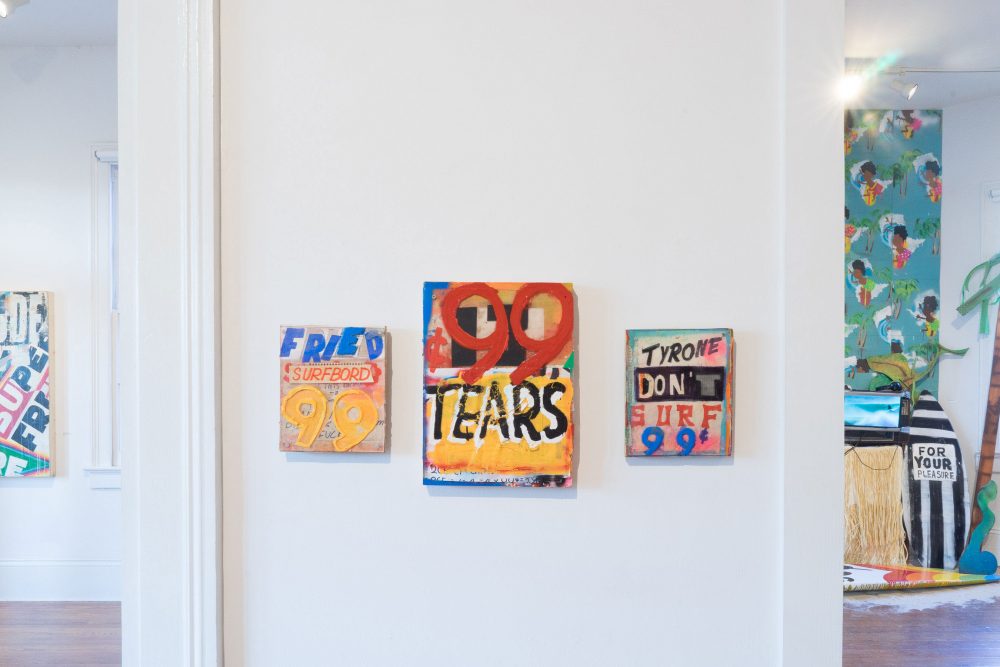Surfin’ U.S.A.: An Interview with Devin Reynolds
Emily Wilkerson talks to artist Devin Reynolds about his recent work, racial stereotypes, and equity in the art world.

Installation view of Devin Reynolds’ “Tyrone Don’t Surf” at Antenna, New Orleans. Courtesy the artist. Photo by Tammy Mercure.
Editor's Note
In late April, New Orleans-based artist Devin Reynolds and I met to walk through “Tyrone Don’t Surf,” his solo exhibition at Antenna. Among about a dozen vibrant paintings and mixed-media works filling the gallery, we went directly to the largest piece in the show, Everyone’s Favorite Black Guy Until its 11pm and hes the only other person on the street, 2018. Spanning two large walls, the painting contains a depiction of Jesus, a surfer’s wetsuit, and a black panther, and is dominated by colorful, graphic text.
Phrases in the painting such as “FREE, FREE, FREE LABOR” and “White Out: FROM BI-RACIAL TO OCTOROON, JUST A DROP IS ALL YOU NEED!” are indicative of the language Reynolds includes in his works throughout the exhibition, addressing issues surrounding identity and his personal experiences as a black man. Standing in front of this massive work, Reynolds pointed out the section of the painting referencing Riker’s Island prison, then dove directly into talking about his family history and childhood growing up in Southern California in the 1990s. This work, like others in the show, encourages visitors to consider words’ and symbols’ relationships to their own lives.
Over the course of almost three hours, we spoke about violence, addiction, God, race, DMX, Fleetwood Mac, kindness, and the politics of working in the arts, among so many other subjects. We talked about young people in New Orleans and Devin’s work tutoring after school at the 7th Ward Boys and Girls Garden, and how his artwork is inspired and informed by his daily experiences in this city. Following that sprawling conversation, we corresponded via email to talk more directly about his art practice.
—Emily Wilkerson
Emily Wilkerson: I think the title of the exhibition, “Tyrone Don’t Surf,” is a great jumping-off point for this conversation. Where did it come from?
Devin Reynolds: I was home [in Southern California] fishing for the summer a few years ago and I was getting out of the car or something and my neighbor was like, “Hey Tyrone, how’s school been?” He and his family have been neighbors to my grandma’s house for 20-something years and it got me thinking how someone can get from Devin to Tyrone. There’s almost no visual or phonetic similarity between the two names.
At the end of that day I went fishing, which all became inspiration for this body of work: Why don’t I run into young black people out fishing? Why are there 100 white guys out surfing and you’re lucky if there’s one black guy? How come you don’t see black people out hiking? I got pretty lucky and had black people in my life who did do those things, which was the happenstance of geographical access, growing up in Venice and Santa Monica. The first people that took me fishing were black and Latino. In a way I got lucky and was shown that I didn’t have to be what I saw on the streets or how Craig and Smokey acted in Friday.
You might say that movies like Friday, or the way we see black men in popular culture, are a reflection of what really exists, but that’s sort of the core of Tyrone not surfing, his being constantly conditioned and tricked into thinking that he has to be “black.” Taking a look at history and its manifestation in our everyday life, the work is a reflection on my life, walking the fine line of falling victim to the cultural conditioning of the black male.
I was always a pretty good kid, but there was always temptation to do stupid shit around me. In the end my dad was so crazy that no one tried to pull me into the really dumb stuff. Sometimes I think he kind of scared me straight, and by the end of ninth grade, I started working on this rock-cod boat, the Betty O, out of Marina del Rey, and instead of kicking it with the homies, fishing occupied just about all of my free time outside of school from that point on.

Installation view of Devin Reynolds’ Everyone’s Favorite Black Guy Until its 11pm and hes the only other person on the street, 2018, at Antenna, New Orleans. Courtesy the artist. Photo by Tammy Mercure.
EW: After high school you moved to New Orleans to study architecture at Tulane University, and left the program in your fifth year. Can you talk about this shift? How has your background in architecture influenced your artwork?
DR: I was done trying to like architecture. My relationship with it was like a semi-arranged marriage that just finally ended in an angry divorce, i.e., a 0.32 GPA. When I made the choice to go to Tulane after being recruited by the Posse Foundation for their scholarship program, I wasn’t mature enough to say no to the adults in my life when it came to the final yes or no. The whole time I was in school I just wanted to be working on a fishing boat back home, and that last year I finally cracked. At the same time, I had taken printmaking and this sign-painting course with Adam Mysock, and I had picked up graffiti again. It had been ninth grade since I had tagged or anything, and I got pretty obsessed with painting trains. Painting trains is like collecting antiques, but they move around the country. Every rail car is different and there’s this whole network of photographers called benchers who take pictures of the cars all over the place.
Architecture school had a big impact on my work ethic and strategy in the studio, while the sign painting and graffiti gave me the framework for understanding lettering and scale. Growing up, the extent of my involvement with my mother’s antique business was never something I thought would find its way into my life. But I guess it’s just like your parents’ music that sounds shitty as a kid. It starts to make sense in your 20s. Mid-century lettering techniques are woven into much of my current body of work, and I’ve started a nice little collection of junk and antiques with awesome lettering on them. Thanks, Mom.
EW: Having grown up in Southern California, and now living in Louisiana for nine years, how has New Orleans influenced the way you work, and maybe even your perceptions, experiences, and outlook on life?
DR: Growing up between Venice, Santa Monica, and Marina del Rey, I was very fortunate, but my dad always made sure that I was aware of the color of my skin. Even though I was biracial and lighter skinned than he was, I will never forget when he showed me Emmett Till’s picture from the newspaper when I was in middle school. Reflecting back on that and a lot of what he educated me on as youngster, my dad did everything he could to steer me away from getting caught up in the streets.
My family came from Louisiana, Arkansas, and Mississippi in the ’40s and ’50s during the Second Migration to the West Coast, so it’s kind of funny that I ended up coming back to where they left. Coming to Louisiana made the color and economic divide more apparent. My life in Los Angeles revolved around surfing and fishing. I’ve been surfing almost my whole life and working on a fishing boat since I was 14, but coming to the South set this light bulb off in my head about how and why people are conditioned to navigate the world in a specific way. Outside of painting my surfboards in high school, I didn’t start painting until about four or five years ago.

Installation view of Devin Reynolds’ “Tyrone Don’t Surf” at Antenna, New Orleans. Courtesy the artist. Photo by Tammy Mercure.
EW: It’s beautiful to hear how much your family has impacted your work. And this brings me to the exhibition’s publication component. MOJO is composed of about half images of your dad with you and your family, and about half images of works of yours. At the gallery, we spoke a lot about your dad, who passed away two years ago. Can you talk about the book, and its importance to this exhibition?
DR: For the content in the book, I was looking for a photo of my dad to dedicate the book to him, and after five hours of crying, looking through pictures, the book ended up being this split between photos of my dad, documentation of my work, and some stuff that informs my paintings. In the end my dad’s photos became the most important part of the book to me. How I was raised and the lens that I see the world through has so much to do with his life experiences and what he passed on to me. In a way the body of work from the show has as much to do with him as it does with me.
EW: To close, I want to bring up a question that we both got really fired up about during our last conversation, because we both believe that art can be a platform for social change: “And then what?” What do you hope visitors will do, think, or say after seeing and experiencing this body of work? Can this change the way we work together?
DR: I can’t hope that anything specific happens. At the very least, I hope you have a conversation with the person next to you about some shit you haven’t talked about before.
Although I don’t necessarily have the capital, financially, socially, or professionally, to make certain changes happen, it would be amazing if people who read this remember to hire black art handlers and assistants. One of the best opportunities I’ve had working in New Orleans was during Prospect.4 as an artist’s assistant, which only came out of [that artist’s] request for a black assistant. That moment meant a lot to me because it showed that she took it upon herself to utilize her position of power to enact physical change.
It’s wild to think that in a city like New Orleans, with so many black people, the demographic of employees in museums and institutions falls so short of representing the greater population. And in many cases the jobs made available to people of color are janitorial or security positions that aren’t geared towards helping them move up through the museums’ ranks. Some of these spaces showing the work of black artists are operating in a traditional white on top, black on the bottom hierarchy system. Plantation shit.
Editor's Note
Devin Reynolds’ “Tyrone Don’t Surf” was on view April 14–May 6, 2018, at Antenna (3718 St. Claude Avenue) in New Orleans.



